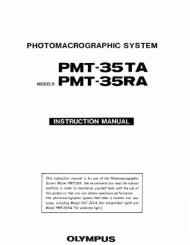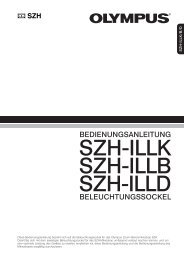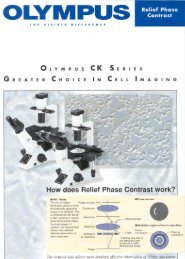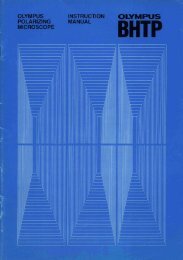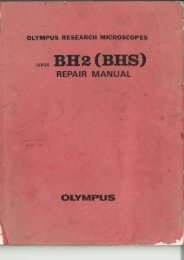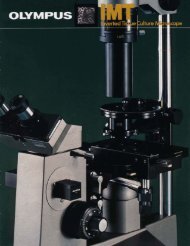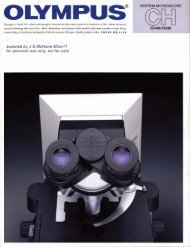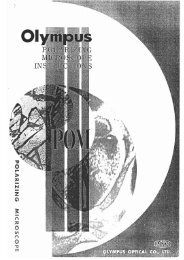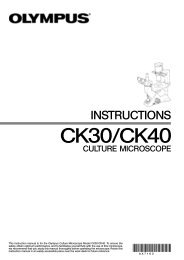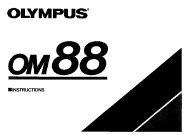Olympus BHS/BHT System Microscopes (BH-2) brochure 1987
Olympus BHS/BHT System Microscopes (BH-2) brochure 1987
Olympus BHS/BHT System Microscopes (BH-2) brochure 1987
You also want an ePaper? Increase the reach of your titles
YUMPU automatically turns print PDFs into web optimized ePapers that Google loves.
<strong>System</strong> <strong>Microscopes</strong>
<strong>BH</strong>2 Series <strong>System</strong> Microscope<br />
The <strong>BH</strong>2 Series of topquality microscopes facilitates the use of a wide range of microscopic<br />
techniques, depending on the choice of accessories. The Koehler-type illumination elicits<br />
the full performance of the LB Series objectives, yielding photomicrographs of the highest<br />
quality. This series of microscopes is suitable for a very wide range of applications, from<br />
routine laboratory work to educational and research investigations.
1. y$,<br />
-<br />
I!, Yt<br />
Wandlng -v<br />
The design of the entire system--microscope<br />
stands, observation tubes, stages, etc.-bears<br />
witness to creative and inventive thinking.<br />
One example may be seen in the design<br />
of the coarse stage adjustment, in which<br />
movement is limited in the upward direction<br />
in order to prevent contact between objective<br />
and specimen. The coarse and fine focusing<br />
knobs are of coaxial design, and the mini-<br />
mum increment on the fine adjustment knob<br />
represents a stage mwernent of just two<br />
microns. The coaxial stage control knobs<br />
are located close to the focusing knobs,<br />
low enough to permit operation witt~wt<br />
having to raise the arm off the arm rest.<br />
In addition, the <strong>BH</strong>2-TR30 trinocular observa-<br />
tion tube features constant tube length<br />
adjustment which allows camera focus<br />
through the binocular tube in phatamicrb<br />
graphy, thereby adding significantly to<br />
ease of operation.<br />
Improved Illumlnatlng <strong>System</strong><br />
All <strong>BH</strong>2 Series microscopes employ the<br />
widely accepted LB Series objectives and<br />
WHKl OX eyepieces (as standard equipment).<br />
providing F.N. 20 widefield observation.<br />
<strong>BH</strong>2 Series microscopes provide Koehler<br />
illumination to exploit the full benefits of the<br />
LB Series objectives. A wide choice of<br />
condensers provides uniform illumina:icm<br />
from ultra low to high magnifications.<br />
These microscopes incorporate precentered<br />
halogen lamps, aspherical collectors and<br />
fully enclosed light paths designed to keep<br />
out dirt and dust.
<strong><strong>BH</strong>S</strong> <strong>System</strong> Microscope<br />
This top quality microscope features a long-life 12V, I# W halogen lamp which provides<br />
bright illumination for a wide range of applications. It is ideally suited for advanced research<br />
work and investigatians requiring high precision.
<strong><strong>BH</strong>S</strong>F Mhwcqm Stand<br />
.The <strong><strong>BH</strong>S</strong>-F stand is of a robust and stable<br />
design unaffected by vibration or shaking.<br />
Highly reliable, it is ideal for photomicro<br />
graphic purposes.<br />
.The stand incorporates a highperfom<br />
transformer which is unaffected by fluctuations<br />
in the line vdtage and so always<br />
provides light of uniform brightness and<br />
mlor temperature.<br />
.The ball bearing sextuple revohring nose<br />
piece accepts law to high magnification<br />
objectives with 45mm parfocal distance.<br />
This feature contributes significantly to<br />
greater efticiency in microscopy.<br />
<strong><strong>BH</strong>S</strong>LSH Halogen Lamp Housing<br />
The IN l W halogen lamp provides a<br />
bright light source suitable for many types<br />
of microscopy. The precentered lamp has<br />
an average life of around 2,000 hours,<br />
reducing slgnlflcantly the time lml with<br />
troublesome bulb change.
<strong><strong>BH</strong>T</strong> <strong>System</strong> Microscope<br />
Employing the same revoking nosepieces, stages, observation tubes, etc., as the Model<br />
<strong><strong>BH</strong>S</strong>, the Model <strong><strong>BH</strong>T</strong> microscope uses a different type of illumination system and electrical<br />
components. A compact microscope, it offers excellent cost-performance.
<strong>BH</strong>FF Mkmscmp Stand<br />
*Smaller than the <strong><strong>BH</strong>S</strong> model, with a<br />
different transformer arKl lighl source.<br />
Extremely functional.<br />
*The dust proof illuminating system keeps<br />
the light path clean.<br />
LS#HI Lamp HWng<br />
Encloses a precentersd 6V 20W halogen<br />
t .
LB (Long Barrel) Objectives<br />
The LB (Long Barrel) Series ranges from inexpensive objectives to top quality and special-purpose<br />
objectives. Thls extensive selection enables the user to choose the ideal lens for the<br />
purpose intended.<br />
In the design of LB objectives, OLYMPUS<br />
has drawn upon its extensive and renowned<br />
expertise In optical technology. The objectives<br />
offer the following features:<br />
1. High resolution<br />
2. Superior contrast<br />
3. Excellent field flatness<br />
4. F.N. 20 widefield observation (with<br />
WHKl OX eyepiece)<br />
5. Ultra-!ow magnification objectives are<br />
parfocal wtth high-magnification lenses.<br />
S Plan Apodumat Objactlm<br />
These objectives are of the highest quality<br />
design. Chromatic aberration is thoroughly<br />
compensated, field flatness is superb and the<br />
high numerical aperture provides outstanding<br />
resolution.<br />
S Plan Aohmmat ObJechs<br />
The S Plan objectives are the most popular<br />
high quality objectives in the LB series.<br />
Excellent optical correction across the<br />
entire lens surfaces makes them ideally<br />
suited for use in differential interference<br />
contrast microscopy and for super widefield<br />
observation.<br />
S Plan FL ObJacthres<br />
The ultra low magnifications (lX, 2X) of these<br />
objectives make them ideal far examinatkm<br />
of large specimen areas. They are fully<br />
parfocal with other LB cbjetiis. The<br />
SRanFL2X objective is suitable for super<br />
widefieid otservatlons.<br />
Note: The objectives prform bast with the <strong>BH</strong>PULC<br />
ultra-low condenser.<br />
D Plan Achromat ObJedw<br />
With D Plan objectives, fleld flatness is<br />
guaranteed up to F.N. 20. Ideal for photo<br />
micrographic purpses, they are widely used<br />
in research, educational and routlne work.<br />
D mrolmt Objective8<br />
These are the most economically priced<br />
objectives in the LB series. Resolution and<br />
flatness in the center portion of the field<br />
of view are excellent and they are particularly<br />
suitable for routine work, educational<br />
purposes or training.<br />
N o ~ O b ~<br />
This type of abjective is ideal for examination<br />
of specimens with no cover glass, such<br />
as blood smears.<br />
'A varlety 01 other types of objectim are available for<br />
dlffarent applicatOwts and requirements, including<br />
phmtrast, reflected light flwrescmce, or<br />
polarked light microscopy.<br />
m I-<br />
sprrn ApochmAIlt<br />
I d d<br />
*<br />
.Prn AahKWnet<br />
I<br />
I<br />
DPknAohr#Mt<br />
No Cover<br />
'R@##B<br />
8~ ~n<br />
I<br />
I+-rl<br />
CC -.,<br />
', --<br />
-<br />
C<br />
'p!
Eyepieces and Condensers<br />
To complement the performance of our LB objectives, an extensive range of eyepieces and<br />
six types of condensers are available. To exploit the full performance of objectives with<br />
magnifications from IX to lOOX requires the choice of the proper condenser.<br />
WHKlNK Eyepieces I h<br />
LB Serbs Eyepieces<br />
Designed for use with LB Series objectives,<br />
WHK eyepieces are easy and comfortable<br />
to use and are of widefield Win (F.N. 20<br />
with the WHKlOX eyepiece). The high eye<br />
point makes them easy to use by persons<br />
who wear glasses and enables fatiguefree<br />
observation over long periods of time.<br />
Other eyepieces in the series include the<br />
WHK8X, WHK15X, NK5X and NK20X.<br />
NFK Serks Photo Eyapkcss<br />
These photo eyepieces are speclflcally<br />
designed for photomicrography. They are<br />
available in 2.5X, 3.3X, 5X and 6.7X<br />
magnifications.<br />
condemm<br />
An extensive range of condensers is available,<br />
covering brightfield and darkfield observations.<br />
The <strong>BH</strong>2-AAC is a top quality achromatic<br />
aplanatic brightfield condenser which permits<br />
full compensation for all aberrations. The<br />
swingat <strong>BH</strong>2-SC condenser is suitable for<br />
a wide range of magnifications. Several other<br />
condensers are available, including the<br />
general-purpose <strong>BH</strong>2CD and the <strong>BH</strong>2-ULC<br />
for ultra-low magnification.
Observation Tubes<br />
All <strong>BH</strong>2 series observation tubes have constant tube length adjustment. This feature<br />
automatically maintains the optimum observation conditions when interpupillary distance is<br />
varied, without requiring troublesome adjustments.<br />
<strong>BH</strong>BB130 Binocular Obswatlon fibe<br />
The <strong>BH</strong>2-6130 is designed exclusively for<br />
visual observation.<br />
Inclination: 30' to the horizontal<br />
lnterpupillary distance: 53-75mm (with<br />
constant tube length adjustment)<br />
Maximum F.N.: 21<br />
<strong><strong>BH</strong>S</strong>TR30 Mrmcular Observation Tube<br />
This tube increases the efficiency of photo<br />
graphic work since it perrnRs camera focusing<br />
through the bkocular section. The three-step<br />
llgM path selector allows photwnicrography<br />
and observation at the same time.<br />
Inclination: 30" to the horizontal<br />
lnterpupillary distance: 53-75mm (with<br />
constant tube length adjustment)<br />
Maximum F.N.: 21<br />
i<br />
<strong>BH</strong>NW Sup.r Wkkfleld Attachment<br />
The <strong>BH</strong>2SW attachment presents the observer<br />
with a field of view about twice the size<br />
of that obtained with wdinarv obwrvatbn<br />
tubes, and thus reduces to a minimum the<br />
need to move the specimen around. This I<br />
resutts in a sinnificant Increase in work 1<br />
efficiency. Ths 3-step light path selector<br />
and constant tube length adjustment allow I<br />
camera focusing through the binocular<br />
section for photomicrography. I<br />
Inclination: 30' to the horizontal<br />
Interpupillary distance: 56-75mm (with<br />
constant tube length adjustment)<br />
Maximum F.N.: 26.5<br />
<strong>BH</strong>2.m Wkal Photohrbe<br />
This tube presents the most economical way<br />
of conducting photomicrography. The bim<br />
cular observation tube must be removed in<br />
wder to attach the vertical phototube and so<br />
ohenration is not pssible at the same<br />
time as photomicrography.
Stages<br />
A selection of stages is available, including those suitable for differential interference contrast<br />
and fluorescence microscopy.<br />
Specimen Holders<br />
<strong>BH</strong>2SVR Mechankal Stage with<br />
RlgM-Hand Low Drfve Contrds<br />
This is the mast popular stage for many<br />
areas of research and testing. Covered ball<br />
races prevent contamination by dust and glass<br />
chips. Scanning area is 76mm O() x 50mm 0.<br />
A 270" rotation capability makes this stage<br />
highly suitabie for photographic framing and<br />
for differential interference contrast purposes.<br />
Note: Range of rotation is reduced to 65' when a Met-<br />
ential interferencecontrast condenser is attached.<br />
<strong>BH</strong>2WL Mechanical Stege with<br />
Left-Hand Low Olhre Controls<br />
Has the same features as the <strong>BH</strong>2-SVR,<br />
except that the controls are located on the left.<br />
<strong>BH</strong>2SH Mechanical Stage wlth<br />
Horhontal [Mvo Contds<br />
The stage controls are horizontally located<br />
on the left- and right-hand sides. The stage<br />
can be rotated through 40' when the stage<br />
control knobs are on the far skJe, and<br />
through 180° when on the near side.<br />
<strong>BH</strong>2SRG Circular Rotatable Stage<br />
This is the ideal stage for Nomarski differential<br />
interference contrast and polarizdlight micro-<br />
scopy. It features a centering mechanism,<br />
and graduations at 1 " intervals around the<br />
entire circumference. Stage diameter is<br />
142mm. It accepts stage clips or KM and<br />
FM attachable mechanical stages.<br />
<strong>BH</strong>2SVFR Grooved Meshanlcl~l<br />
Stage with<br />
Right-Hand Law hfve Controls<br />
The fluted design prevents slides sticking<br />
to the stage surface due to spilled immersion<br />
oil, thus eliminating interruptions In micrs<br />
scopic work. The X-axis excursion is 52rnm,<br />
and Y-axis excursion is 76mm. The stage<br />
rotates through 270'.
<strong>BH</strong>2-PC Phase Contrast Attachment<br />
<strong>BH</strong>2-KPC Simple Phase Contrast Attachment<br />
Phasecontrast is one of the most commonly used techniques in microscopy. It is employed<br />
in the examination of living micro-organisms, cells, etc., permlttlng observation of the<br />
internal structures of such specimens under differen f degrees of contrast.<br />
BWPC Pham Contnst Attachment<br />
*Features an Abbetype turret condenser<br />
wtth a numerical aperture of 1.25.<br />
Incorporates annular phase plate for lox,<br />
20X, 40X and 100X phase objectives.<br />
Incorporates an aperture diaphragm for use<br />
in brighMeld. This diaphragm Is automatically<br />
disengaged in phasecontrast observation.<br />
*The CT-5 centering telescope with hQh eye<br />
point permits slmple and accurate annulus<br />
alignment.<br />
*The <strong>BH</strong>2SW super widefield attachment<br />
used in conjunction with S Plan phase-<br />
contrast objectives enables observation of<br />
super widefield phase contrast images.<br />
*Four types of mtrast-PL, PLL, NH and<br />
NM-are available.<br />
Two types of objectives are available for<br />
phasecontrast microscopy: S Plan Achre<br />
mats and D Achromats. They come in<br />
magnifications of 10X 2OX, 40X and<br />
100% and in bth positive and negative<br />
contrast.<br />
<strong>BH</strong>2-KPC Slmple Phese Contnst<br />
Attachment<br />
Used in conjunction with a <strong>BH</strong>2CD brightfield<br />
condenser and phase contrast objectives,<br />
this attachment presents phase contrast<br />
images easily and economically. Available<br />
in 1OX 20X and 40X magnifications. I<br />
PL = POSI~VE<br />
LOW NH = NEGATIVE HIGH<br />
PU= POSITIVE LOW-LOW NM =NEGATIVE MEDIUM
-~ - -<br />
Abbe Condenser -. . . -. . .<br />
Green Filter<br />
Phase annular ring<br />
--<br />
Phase Contrast Oblect~ve<br />
--<br />
Module<br />
.<br />
<strong>BH</strong>2-PC1 ORS<br />
ED<br />
.-<br />
- --<br />
i P<br />
I OXPL<br />
--<br />
PCD20XPL<br />
@ Q<br />
-@<br />
PCD40XPL<br />
Q) ' 8<br />
PT C<br />
chrornat NH<br />
bl "<br />
, PC D Achromat NH<br />
I
<strong>BH</strong>2-N IC Nomarski Differential<br />
Interference Contrast Attachment<br />
The Nomarski differential interference technique is used for unstained specimens, such as<br />
living cells. Intercellular structure end surface variations can be obsenred as a three<br />
dimensional image under various interference colors.<br />
*The turret condenser (NA 1.40) is fitted<br />
with Nomarskl brisms for lox, 20X, 40X and<br />
lOOX magnifications, as well as light annuli<br />
for 1 OX and 40X phase contrast microscopy.<br />
These features enabte cornparisms<br />
bemen phase contrast and DIC images<br />
with the greatest of ease.<br />
aSiandard S Plan Achmt objecth can<br />
be used for DIC microscopy. Super<br />
widefield DIC observation is also possible.<br />
.Has an opem aperture for briihtfield<br />
chewation.<br />
.The Internate attachment has s magnifi-<br />
cation factof of 1 .a.<br />
*IF550 interference filter uGhmv
15<br />
<strong>BH</strong>2-RFL Reflected Light Fluorescence Attachment<br />
The development of new optics makes it possible to use high-energy exciting light,<br />
providing brighter fluorescence and improved results.<br />
.Three levels of exciting light intensity<br />
are available: 100%, 25% and 0%.<br />
.An aperture diaphragm allaws ttle precise<br />
regulation of exciting light intensity and<br />
fluor- image contrast.<br />
*Features a built-in field diaphragm with<br />
centering mechanism. This feature eliminates<br />
stray llgM which caw flares and<br />
reduces image clarity.<br />
*The synchronized exciting filters, dichroic<br />
mirrors and barrier fitters all move together,<br />
allowing swttch over between two wave<br />
h g b at a single touch. F i types of<br />
exciting filter sliders are available, each<br />
Wing two exciting fitters. Exciting filters<br />
come in five combinatians: U-V, B-G, U-B,<br />
Bu and UG.<br />
*Additional exciting filters and barrier filters<br />
W Y be employed.<br />
mFluorescence attachments using a halogen<br />
ligM arce are available for use with FlTC<br />
staind s~ecirnens which can be examined<br />
with a retatlvely small amount of exciting<br />
., .. 1 . . .<br />
I F -<br />
light. Both reflected light and transmitted<br />
light types are available.<br />
Btl2-RFLB<br />
A reflected lit fluorescence attachment<br />
with halogen tight source, designed for B<br />
excitetian.<br />
<strong>BH</strong>2-FITW<br />
These hNo transrnittdQht fluorescence<br />
units are designed specifically for B<br />
excitation and emplay the lmtt halogen<br />
lamp in <strong><strong>BH</strong>S</strong> microscope as their light<br />
source. The secondary transmission region<br />
at about 630n m in these FtTC filters enables<br />
the observation of non-fluorescence areas<br />
under red &Meld illumination.<br />
*D Plan Apo UV Series objectives<br />
feature an apochromatic design to correct<br />
b<br />
chr~maticabermtkrtscwerawidewavelerigth<br />
range. This design guarantees a sharp<br />
knage and brlgM Inmination in any excitatian.<br />
The new, flwrescencefree imrsbn oil<br />
is also suitable for other dl Immersion<br />
~usedforgeneral~tion.<br />
~alsooffersallneupof4typesof<br />
fluorescent phase contrast objectives<br />
(D Plan Apo/D Apo UVPL Series).<br />
When a flwrescent specimen is being<br />
scanned, fading of fluorescent light can be<br />
pwnted by switoh'hg to phase mtrast<br />
~.Whenrellectedl'~fiuorescence<br />
and transmitted IIgM phase contrast<br />
&mmtim are performed simultanewsly,<br />
an entire specimen Image, induding the<br />
non-fluorescent area, can be obtained.<br />
D Plan ApolD Apo UV Series D Plan ApolD Apo WPL Series -
iH2-RFL Standard OU<br />
- '7<br />
7 mu<br />
U Excltatlon a Excitation<br />
<strong>BH</strong>2-FITC Standard Ouffits<br />
m<br />
Excitation FlTC Interference Filter Set<br />
...<br />
(Transmitted light)
Attachments for Group Observation<br />
Here is a group of very useful accessories which allow simultaneous viewing by several<br />
observers. This is a parficularly convenient feature for discussions between researchers,<br />
and is indispensable for teaching purposes.<br />
<strong>BH</strong>2-MDO MUHI-viewing Attachment<br />
.Permits simultaneous observation of the<br />
same specimen image in the same orienta-<br />
tion by up to five persons.<br />
*The arrow painter can be moved to indicate<br />
any area of the specimen. Pointer color<br />
(green or orange) can be changed, and<br />
brightness adjusted.<br />
Standard Outfits<br />
<strong>BH</strong>2-00 Dual-viewlng Attachment<br />
.The features are exactly the same as the<br />
<strong>BH</strong>2-MDO, except that tl permits observation<br />
by two persons.<br />
*There is ample distance between the<br />
oberver posklons, allowing relaxed viewing.<br />
*The second observer may manipulate the<br />
pointer by means of an additional lever<br />
located on the opposite side from the<br />
main lever.<br />
Standard Outfits<br />
is used on a <strong><strong>BH</strong>S</strong> <strong>System</strong> mkrmeape.
AHSPSW Hlgh Resdutlon<br />
Projectlcm Semen<br />
Eye strain is minimal even after long periods<br />
of viewing thanks to the high resolution<br />
presented by this screen.<br />
Effective diameter: 155mm<br />
Screen image magnification: Objective<br />
magnification x NFK photo eyeDiece<br />
magnification x 3<br />
AH-MPSW Pmjecth Semen<br />
The AH-MPS-W is extremely useful in small<br />
group viewing and discussions.<br />
Effective diameter: 155mm<br />
Screen image magnification: Objective<br />
magnification x NFK photo eyepiece<br />
magnification x 3<br />
<strong>BH</strong>-WP Wall Projdon Prkm<br />
Used to project an image onto a wall<br />
or screen.
PM-IOADSIPM-10AD Photomicrographic and<br />
Cinemicrographic <strong>System</strong>s<br />
These fully automatic Photomicrographic systems are designed for exclusive use with microscopes.<br />
A built-in microcomputer assures easy and failurefree operation. They can also be operated<br />
manually, and both accept large format film.<br />
PM-1OAbS Autamatk Pbtmicrographk<br />
SY-m<br />
.Features both spot (1 %) and Integrated<br />
(30%) metering.<br />
mThe built-In mlcrocwnputer autamatically<br />
cwnptwates for a film's recipmity failure<br />
characteristics and cmtrols expmre time<br />
correctly even during lmg exposures.<br />
*An exposure adjustment feature allows the<br />
precise control of expmre tlme to match<br />
the spclmen's characteristics.<br />
*Incorporates an AE lock mechanism,<br />
useful when trimmlng with spot metering<br />
or to keep density unlform in wntlnuws<br />
pmorarnic photography.<br />
Manual exposure control is also available.<br />
.Accepts the following types of film: 3Smm;<br />
4" x 5" sheet; and 3'k" x 4lk" Polaroid.<br />
*The multiple exposure mechanism enables<br />
a number of images to be recorded on the<br />
same frame of film.<br />
PM-IOAD Aul~metlc Photoml~r~grephk<br />
w-n<br />
Has the same features as the PM-1MS<br />
except that it provides only 60% metering<br />
with 35mm film.<br />
Note: This system accepts practically dl the accas-<br />
sorb avellable for the PM-tOADS.<br />
PMCTR Cobr Tompatun Modub<br />
The PMCTR measures color temperatures<br />
from 2,500K to 10,000K. It provides greater<br />
accuracy In color temperature readings.<br />
PM-IV Ttms L ap Control Unlt<br />
Used in conjunction with the PM-1OADS or<br />
PM-I OAD, this unit automatically controls<br />
the intervals in timelapee photography.<br />
Intervals can be set f m one second to<br />
99.9 hours. Permits a total of 9999 frames<br />
to be taken.<br />
PM-VSB BrlgMhame Mlnrkr<br />
Thls viewNnder Is optionally available for the<br />
<strong>Olympus</strong> Photomicrographic <strong>System</strong>s<br />
PM-1OADS and PM-1 W.<br />
Focusing on the double crosslines and the film<br />
format frames when photographing dark<br />
specimens against a dark background is<br />
greatly facilitated by the fact that the frame<br />
reticle is illuminated and the color of the<br />
frame can be varied from black to red or yellm.
<strong><strong>BH</strong>S</strong>KP Sknple PolaWng Attachment<br />
This attachment enables polarized-light<br />
microscopy using ordinary LB objectives.<br />
A tint plate and other compensators can<br />
be used with it.<br />
Standard Outffts<br />
<strong>BH</strong>*POL Palarfdn~ Flht Set<br />
Consisting of a palarlzer and an analyzer,<br />
this accessory is usefull for detecting<br />
birefringent specimen details.<br />
<strong>BH</strong>MA MagnHkatkn Changer<br />
Magnification can be set at three levels:<br />
1 X, 1.2% and 1.5X. The phasecontrast annuli<br />
can be aligned with the bullt-In Bertrand lens.<br />
<strong>BH</strong>2-DA Drawing Attachment<br />
Very useful in the accurate sketching of a<br />
magnified specimen image seen through the<br />
microscope. Adjustable magnficatbn.<br />
BBFH =gout Fllter Hdckr<br />
Holds three filters at one time. Rtters can<br />
be exchanged at the touch of a finger,<br />
resulting in more efficient observation and<br />
photomicrography.<br />
I<br />
<strong>BH</strong>2.KP .<br />
y- m<br />
A \ - ?. . - b<br />
<strong>BH</strong>-POL BWe4<br />
- / /><br />
'\A /<br />
/<br />
b<br />
.. -. .- -<br />
...:;A<br />
.<br />
I
1. Candidiosls (UuOdenurn, Grooott stain). SPlanP(, NFK2.5XLD<br />
2 Alkaline phosphatase (liver). SPlanlOX, NFK3.3XL.D<br />
3. Acld phosphatase (spleen of Gaucher's disease). SPlanlOX, NFK3.3XLD<br />
4. Nlcotin amkie adenine dinucleatide phosphate dehyclrqlmase (cell line derived<br />
from human malignant melanoma-SEKI). SPlen40X, NFK3.3XL.D
liaaram of the <strong><strong>BH</strong>S</strong>. <strong><strong>BH</strong>T</strong> and PM-IOAD. PM-IOADS
Svstem
25<br />
=sPlan<br />
L R nhjective Series for Biological Use<br />
S Plan Fluorite Obiedvea<br />
D Plan Achromatic Objectives<br />
D Achromatic Objectives<br />
Phase Contrast Objectives<br />
7 s 1a.a aw.<br />
Q.46 1s 8.03 aw, w.<br />
*dfY % 0.70 9s 4-13 S.W" SprOrgbrdab<br />
tQ@XJGlk I& a.17 I.& s.w., spfwomw<br />
R t<br />
t&aa m mt' tern<br />
NM<br />
PL<br />
-.<br />
.- 4<br />
Denote: S.W. = Su r WIdefiM. PL = Podth Low Contmst. PLL- Positive LowLow Contrast. NH = Negatlve Hlgh Contrast. NM = Negatlva Medium Contrast.<br />
D.1.C. = &8lskl DIff~liltIth! hiWfBliMC9 c0ntf8~t.
UM3.3XLD -<br />
rlFK5XLD -<br />
LB Eyepiece Series<br />
to Eyepieces
It takes a tremendous amount of skills to build a reputation<br />
as an innovator among industries as diverse as<br />
communications, medicine, information and science<br />
Yet that's exactly what <strong>Olympus</strong> has accomplished<br />
since its inception in 1919.<br />
Our varied product list is filled with technological<br />
achievements and resounding successes.<br />
Not only in cameras, but also in a wide range of <strong>Microscopes</strong>.<br />
Fiberscopes. Microcassette recorders.<br />
Clinical analysis equipment. Video equipment<br />
And more breakthroughs are on the way,<br />
particularly in the exciting new field of optt~lectronics,<br />
which combines the resources of optics,<br />
electronics and precision engineering.<br />
At <strong>Olympus</strong>, we've earned our reputation<br />
with an unfailing commitment to heavy research and<br />
development With an uncompromising dedication to quality,<br />
precision and accuracy.<br />
And with a stubborn unwillingness to follow the crowd.<br />
That's why we'll continue to lead the way<br />
with original products that surprise you,<br />
assist you, involve you, and fulfill you.<br />
1 Photographic.<br />
Medical,<br />
Microscopic,<br />
Industrial & Business Equipment<br />
4 Newdp O W. l& SUCcB88. N.Y. 11042.1 179. USA<br />
~a2z2EE%uKJ-<br />
A r t u r ~ c ~ n ~ d ~ f m p m ~ ~ d ~ p i ~ theeqtdpmeetsyppbidrnoy~tv<br />
o l v p m d w ~<br />
itadl~dthrk~pbbnr~imUbutio~~srkwrnin thiaw.<br />
Printecl in Japan M18E-09876



